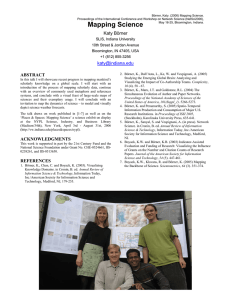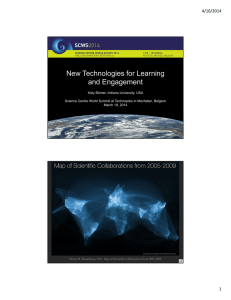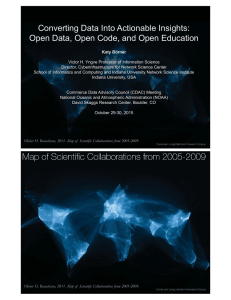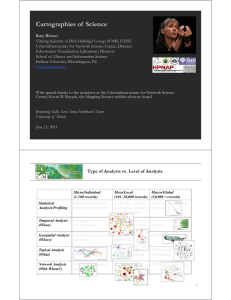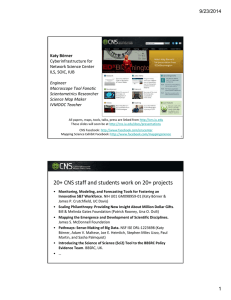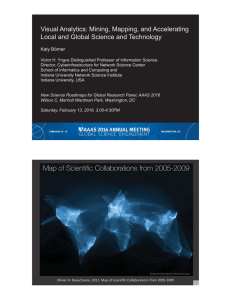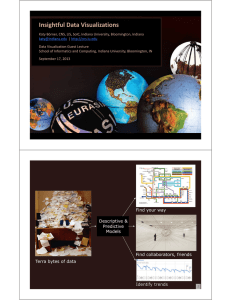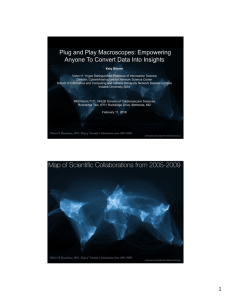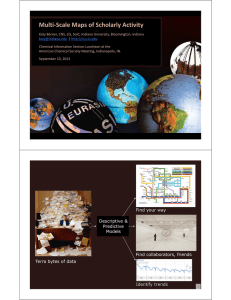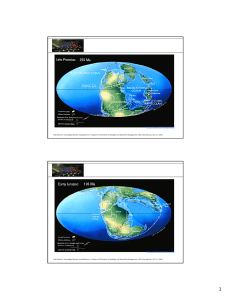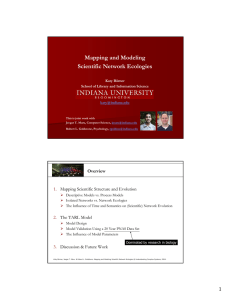Mapping, Illuminating, and Interacting with Science (sap_0116)
advertisement
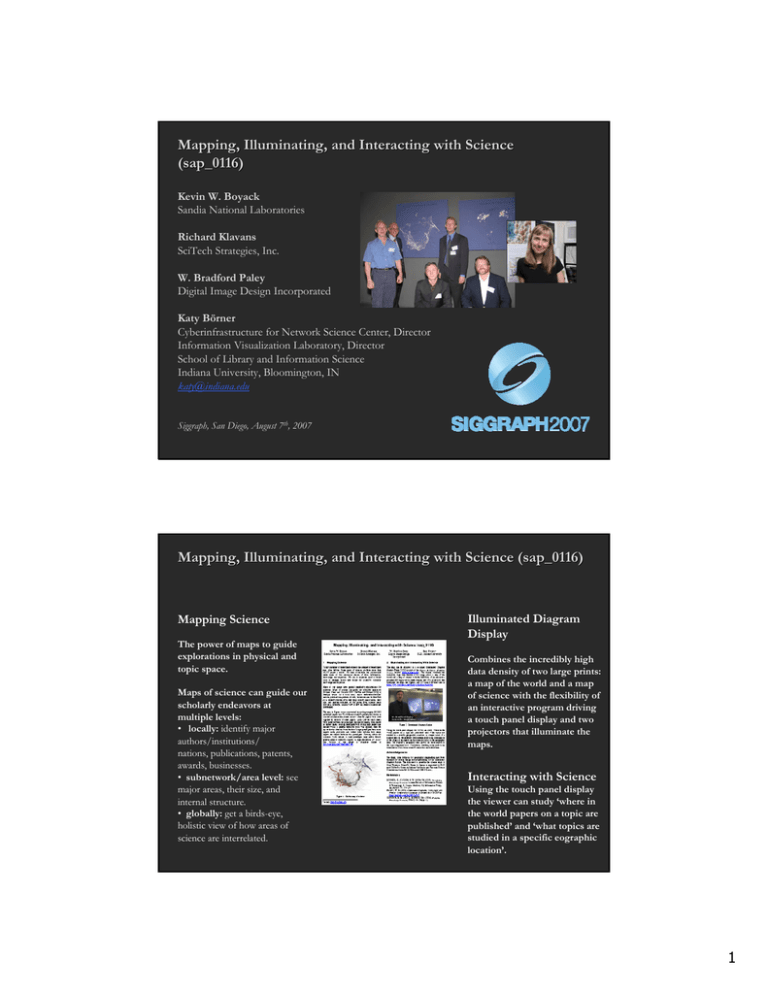
Mapping, Illuminating, and Interacting with Science (sap_0116) Kevin W. Boyack Sandia National Laboratories Richard Klavans SciTech Strategies, Inc. W. Bradford Paley Digital Image Design Incorporated Katy Börner Cyberinfrastructure for Network Science Center, Director Information Visualization Laboratory, Director School of Library and Information Science Indiana University, Bloomington, IN katy@indiana.edu Siggraph, San Diego, August 7th, 2007 Mapping, Illuminating, and Interacting with Science (sap_0116) Mapping Science The power of maps to guide explorations in physical and topic space. Maps of science can guide our scholarly endeavors at multiple levels: • locally: identify major authors/institutions/ nations, publications, patents, awards, businesses. • subnetwork/area level: see major areas, their size, and internal structure. • globally: get a birds-eye, holistic view of how areas of science are interrelated. Illuminated Diagram Display Combines the incredibly high data density of two large prints: a map of the world and a map of science with the flexibility of an interactive program driving a touch panel display and two projectors that illuminate the maps. Interacting with Science Using the touch panel display the viewer can study ‘where in the world papers on a topic are published’ and ‘what topics are studied in a specific eographic location’. 1 Mapping Science ¾ Börner, Katy, Chen, Chaomei, and Boyack, Kevin. (2003). Visualizing Knowledge Domains. In Blaise Cronin (Ed.), Annual Review of Information Science & Technology, Volume 37, Medford, NJ: Information Today, Inc./American Society for Information Science and Technology, chapter 5, pp. 179-255. ¾ Shiffrin, Richard M. and Börner, Katy (Eds.) (2004). Mapping Knowledge Domains. Proceedings of the National Academy of Sciences of the United States of America, 101(Suppl_1). ¾ Börner, Katy, Sanyal, Soma and Vespignani, Alessandro (in press). Network Science. In Blaise Cronin (Ed.), Annual Review of Information Science & Technology, Information Today, Inc./American Society for Information Science and Technology, Medford, NJ. ¾ Places & Spaces: Mapping Science exhibit, see also http://scimaps.org. Process of Analyzing and Mapping Science , Topics Börner, Chen & Boyack. (2003) Visualizing Knowledge Domains. In Blaise Cronin (Ed.), Annual Review of Information Science & Technology, Volume 37, Medford, NJ: Information Today, Inc./American Society for Information Science and Technology, chapter 5, pp. 179-255. 4 2 Places & Spaces: Mapping Science a science exhibit that introduces people to maps of sciences, their makers and users. Scimaps.org Exhibit Curators: Dr. Katy Börner & Julie Smith 5 10 iterations in 10 years 1st Iteration in 2005: The Power of Maps 2nd Iteration in 2006: The Power of Reference Systems 3rd Iteration in 2007: The Power of Forecasts 6 3 7 http://scimaps.org. 4 Map of Scientific Paradigms(2nd Iteration) by Kevin W. Boyack and Richard Klavans 800,000 published papers were grouped into 776 different scientific paradigms (shown as colored circular nodes) based on how often the papers were cited together by authors of other papers. Links (curved black lines) were made between the paradigms that shared papers, then treated as rubber bands, holding paradigms with strong links nearer one another while a general repulsive force was applied; thus the layout derives directly from the data. Larger paradigms have more papers; node proximity and darker links indicate how many papers are shared between two paradigms. Flowing labels list common words unique to each paradigm, large labels denote general areas of scientific inquiry. Redesign by W. Bradford Paley 5 6 7 8 Illuminated Diagram Display (VIDEO: 4:104:10-8:45) Places & Spaces: Mapping Science exhibit at NYPL, New York, 2006 Places & Spaces: Mapping Science exhibit at ACM in Chicago, 2007 9 Places & Spaces: Mapping Science exhibit at MCPL in Bloomington, IN, 2007 Places & Spaces: Mapping Science exhibit at MCPL in Bloomington, IN, 2007 10 Re-implementation of Illuminated Diagram Software (in progress) by Advanced Visualization Lab, Indiana University Drives unlimited number of ID screens. Science World Medicine Asia Touch screen for direct interaction. Keyword and name search. Selection of canned queries for - interdisciplinary research areas - famous people - activity patterns, e.g., bursts, trends, etc. Japan … … Cancer CAREER: Visualizing Knowledge Domains. NSF IIS-0238261 award (Katy Börner, $451,000) Sept. 03-Aug. 08. http://iv.slis.indiana.edu/ SEI: Network Workbench: A Large-Scale Network Analysis, Modeling and Visualization Toolkit for Biomedical, Social Science and Physics Research. NSF IIS-0513650 award (Katy Börner, Albert-Laszlo Barabasi, Santiago Schnell, Alessandro Vespignani & Stanley Wasserman, Eric Wernert (Senior Personnel), $1,120,926) Sept. 05 - Aug. 08. http://nwb.slis.indiana.edu 22 11 References ¾ ¾ ¾ ¾ ¾ ¾ ¾ ¾ ¾ ¾ ¾ Bruce Herr, Weixia Huang, Shashikant Penumarthy, Katy Börner. Designing Highly Flexible and Usable Cyberinfrastructures for Convergence. Submitted to William S. Bainbridge (Ed.) Progress in Convergence. Annals of the New York Academy of Sciences. Börner, Katy. Mapping All of Science: How to Collect, Organize and Make Sense of Mankind’s Scholarly Knowledge and Expertise. Accepted for Environment and Planning B, Special Issue on Mapping Humanity's Knowledge and Expertise in the Digital Domain. Börner, Katy, Penumarthy, Shashikant, Meiss, Mark and Ke, Weimao. (2006) Mapping the Diffusion of Scholarly Knowledge Among Major U.S. Research Institutions. Scientometrics. 68(3), pp. 415-426. Holloway, Todd, Božicevic, Miran and Börner, Katy. Analyzing and Visualizing the Semantic Coverage of Wikipedia and Its Authors. Accepted for Complexity. Also available as cs.IR/0512085. Katy Börner. (2006) Semantic Association Networks: Using Semantic Web Technology to Improve Scholarly Knowledge and Expertise Management. In Vladimir Geroimenko & Chaomei Chen (eds.) Visualizing the Semantic Web, Springer Verlag, 2nd Edition, chapter 11, pp. 183-198. Boyack, Kevin W., Klavans, R. and Börner, Katy. (2005). Mapping the Backbone of Science. Scientometrics, 64(3), 351-374. Hook, Peter A. and Börner, Katy. (2005) Educational Knowledge Domain Visualizations: Tools to Navigate, Understand, and Internalize the Structure of Scholarly Knowledge and Expertise. In Amanda Spink and Charles Cole (eds.) New Directions in Cognitive Information Retrieval. Springer-Verlag, Netherlands, chapter 5, pp. 187-208. Börner, Katy, Dall’Asta, Luca, Ke, Weimao and Vespignani, Alessandro. (April 2005) Studying the Emerging Global Brain: Analyzing and Visualizing the Impact of Co-Authorship Teams. Complexity, special issue on Understanding Complex Systems, 10(4): pp. 58 - 67. Also available as cond-mat/0502147. Ord, Terry J., Martins, Emília P., Thakur, Sidharth, Mane, Ketan K., and Börner, Katy. (2005) Trends in animal behaviour research (1968-2002): Ethoinformatics and mining library databases. Animal Behaviour, 69, 1399-1413. Supplementary Material. Mane, Ketan K. and Börner, Katy. (2004). Mapping Topics and Topic Bursts in PNAS. Proceedings of the National Academy of Sciences of the United States of America, 101(Suppl. 1):5287-5290. Also available as cond-mat/0402380. Börner, Katy, Maru, Jeegar and Goldstone, Robert. (2004). The Simultaneous Evolution of Author and Paper Networks. Proceedings of the National Academy of Sciences of the United States of America, 101(Suppl_1):5266-5273. Also available as cond-mat/0311459. Acknowledgements We thank John Burgoon for geographic mapmaking and Peter Kennard for system design and programming for the illuminated diagram display. The Advances Visualization Lab at Indiana University designed the screen based ID setup. The data used to generate the science maps is from Thomson Scientific. Places & Spaces is supported by SLIS, CI4NetSci Center, UITS, all three at Indiana University and National Science Foundation awards IIS-0238261 and CHE-0524661. 12
